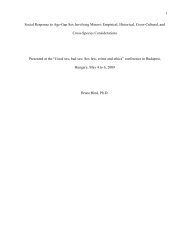Infant and Child Sexuality: A Sociological Perspective - Ipce
Infant and Child Sexuality: A Sociological Perspective - Ipce
Infant and Child Sexuality: A Sociological Perspective - Ipce
You also want an ePaper? Increase the reach of your titles
YUMPU automatically turns print PDFs into web optimized ePapers that Google loves.
suited to their tastes. They force adults to revise their behavior;<br />
adults must deal with them on their own terms. Rather than cuddling<br />
them, they must communicate <strong>and</strong> interact with them in other ways--smile<br />
at them, speak to them, rock or roughhouse with them, <strong>and</strong> play with<br />
them through the medium of toys. Whereas the cuddly child may have many<br />
encounters that are of a directly physical, fondling, <strong>and</strong> potentially<br />
erotically-stimulating type, the non-cuddler by choice does not have<br />
these experiences. It may be hypothesized that the cuddly child by his<br />
actions actively seeks sensual <strong>and</strong> erotic stimulation <strong>and</strong> response.<br />
There is no clear dividing line, however, between relations which are<br />
erotic in the restricted meaning of that word <strong>and</strong> those which are not.<br />
Since the encounters with mother in the normal course of infantmother<br />
relations are numberless <strong>and</strong> infinitely varied, each requires a<br />
different adaptive response. Self stimulation in the form of thumb<br />
sucking has been observed prenatally. The first somato-sensory encounter<br />
of the newborn infant <strong>and</strong> mother is the birth experience itself.<br />
Male babies are sometimes born with erections; whether this is due to<br />
internal stimulation or the birth experience itself has not been determined.<br />
It is reasonable to assume that it is in part due to the tactile<br />
stimulation of the birth experience. It is now understood that the<br />
birth experience may result in some pain for both mother <strong>and</strong> infant,<br />
nevertheless mothers have reported erotic experience during the delivery,<br />
including sexual climax. (Ziegler <strong>and</strong> Rodgers, 1968, p. 186) Hence<br />
the birth experience has the potential of being an erotic experience<br />
for both infant <strong>and</strong> mother.<br />
The major tactile <strong>and</strong> potentially erotic encounter involving infant<br />
<strong>and</strong> mother is, of course, the sucking relationship. The mechanisms<br />
of sucking are simple. The infant is born with a sucking reflex<br />
which is stimulated by the touch of an object on the cheek or lips. The<br />
infant turns its head toward the object (in this case the nipple),<br />
opens its lips, <strong>and</strong> starts to suck when the nipple is placed in the<br />
mouth. Though sucking is a reflex action, practice helps. The mother is<br />
likely to notice the infant’s increased skill in sucking that comes<br />
with practice. As the control of neck muscles improves, the infant becomes<br />
more <strong>and</strong> more efficient at getting into place <strong>and</strong> finding the<br />
nipple for himself. (Sears et al, 1957, p. 64, 66).<br />
The sucking encounter is a co-operative venture of infant <strong>and</strong><br />
mother. Success depends on the behavior of the infant as well as the<br />
behavior of the mother. From the infant’s side, behavior problems can<br />
occur because of inefficient sucking, apparent dislike of the nursing<br />
situation, <strong>and</strong> lack of responsiveness. The infant can be fickle <strong>and</strong> dem<strong>and</strong>ing.<br />
The situation has to be “right” or he may refuse to participate.<br />
Robinson observed that many infants whose mothers fed them<br />
strictly by the clock refused “point blank” to take the breast after<br />
the age of three months <strong>and</strong> had to be bottle fed. (Robinson, 1968, p.<br />
123). The breast was not refused if the mother was “easy-going” <strong>and</strong> fed<br />
her infant by “instinct” rather than by the clock. On the other h<strong>and</strong>,<br />
scheduling of infrequent feedings causes the breast to be overfull, so<br />
that when nursing begins the milk may spurt out <strong>and</strong> choke the infant.<br />
This interference with the infant’s breathing, although only temporary,<br />
may instill fear or ambivalence toward the nursing process. Ejection-reflex<br />
failures are also related to the infant’s dislike of breast<br />
feeding, since the infant responds favorably to a consistent supply of<br />
11
















